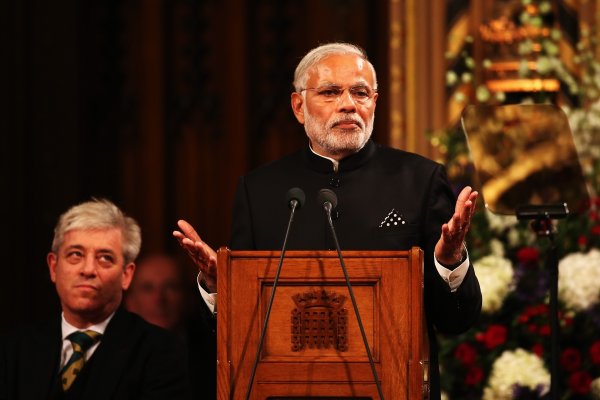
When the Modi government came to power exactly two years ago, one of its main economic agendas was boosting investment, both foreign and domestic. Prime Minister Modi pushed for an increase in foreign direct investment (FDI) as a remedy to all of India’s macroeconomic woes. However, an examination of investment numbers over the last two years reveals a mixed picture.
Foreign Direct Investment Push
With the objective of increasing FDI, the Make in India program, launched in September 2014, has resulted in a number of foreign enterprises investing in sectors such as defense manufacturing, automobiles, electronic systems, renewable energy, and railways, to name a few. From June 2014 to January 2016, there has been around 48 percent growth in FDI inflows. This is good news considering the fact that FDI in February 2014 was the lowest during the 1995 to 2016 period (as shown in Figure 1).
Figure 1: Foreign Direct Investment (From January 1, 2013 to May 11, 2016; bi-annual figures in US$)
Source: Reserve Bank of India database (Trading Economics)
The increase has largely been made possible by a string of policy measures enacted to ease regulatory and procedural formalities in setting up and running a business. The improvement in ease of doing business has been bolstered by the announcement of policy initiatives such as Skill India, Digital India, Start-Up India, and Smart Cities, which will improve human capital and infrastructural capacity, thus helping to attract investment.
Increasing Outward Foreign Direct Investment (OFDI)
Though FDI has risen, if we observe the domestic industrial performance levels and the business confidence index, performance seems to be quite weak, due to both internal and external (endogenous and exogenous) factors.
Figure 2: India’s Business Confidence Index
Source: Confederation of Indian Industry (CII) data (Trading Economics)
While India continues to attract foreign investment in newly opened up sectors, its own businesses are stagnating in their domestic performance and looking for opportunities to invest abroad/off-shore. Most Indian firms have invested abroad through Mergers and Acquisitions (M&As) transactions. As per a recent estimate, “M&A activity increased in 2014 with deals worth US$ 38.1 billion, compared to US$ 28.2 billion in 2013 and US$ 35.4 billion in 2012. There have been M&A deals worth US$ 28.8 billion in the first 10 months of 2015.”
This perceptible shift in Overseas Foreign Direct Investment (OFDI) and Overseas Investment Destination (OID) in the last few years is an interesting trend to observe. This can at least partly be due to a delay in the implementation of key reforms in India. As is evident from Figure 2, the index picked up immediately after the government came to power in May 2014 due to positive sentiment (driven by the Bharatiya Janata Party’s political majority, change in regime, and the perception of Modi as a pro-market/business leader). However, due to a slow-moving legislative process and limited action on the ground, the index has dropped down again. Additionally, increasing levels of domestic private debt may be making private firms wary of investing within India vis a vis abroad. Weak global commodity prices and low international aggregate demand for Indian goods could also be factors.
Challenges Ahead
The fate of the long-awaited Goods & Services Tax (GST) bill and the Companies Amendment Bill echoes the Modi government’s political failure in enacting key reforms. In a recent article, I discussed how this has arisen due to institutional challenges (present at the legislative, executive, and judicial level). These are primarily responsible in negatively impacting local business confidence levels, despite the projection of a progressive economic regime.
There is also a degree of over-centralization associated with the Prime Minister’s Office (PMO), which appears more presidential (as in the American political machinery) than federalist, which is germane to the Indian political economy framework. The over-centralized approach has made state-level implementation of key reforms a challenge.
Another point to note is that over reliance on FDI as a remedy to all investment and financial woes is largely driven by the neoliberal framework of the 1960s, the Solow model. The evidence in support of FDI causing local level job creation, technological development and back-end infrastructural development in India is weak (excluding the case of the capital goods segment since the early 1990s). Thus, policymakers must guard against over-dependence on foreign borrowing and investment as a sustainable measure to increasing economic growth. Economic history of East Asian countries during the 1980s and 1990s shows that an over-dependence on foreign capital may result in a capital account crisis in the long run.
The government must consider alternate solutions to sustaining economic growth by prioritizing Track II reforms (as argued by Jagdish Bhagwati and Arvind Panagariya) that are key to the economic development of the lowest strata of Indian society. This can be done by focusing on enhancing access to quality education and healthcare (particularly at a primary level), as means for communities to get the opportunity to develop. The focus on driving greater investment must be complimented by socially investing the physical capital, for long term returns in the form of human and knowledge capital.
***
Image: Dan Kitwood, Getty

